
- Afhalen na 1 uur in een winkel met voorraad
- Gratis thuislevering in België vanaf € 30
- Ruim aanbod met 7 miljoen producten
- Afhalen na 1 uur in een winkel met voorraad
- Gratis thuislevering in België vanaf € 30
- Ruim aanbod met 7 miljoen producten
Zoeken
Cultural Translations in Medieval Romance
€ 177,45
+ 354 punten
Omschrijving
Romance was the most popular secular literature of the Middle Ages, and has been understood most productively as a genre that continually refashioned itself. The essays collected in this volume explore the subject of translation, both linguistic and cultural, in relation to the composition, reception, and dissemination of romance across the languages of late medieval Britain, Ireland, and Iceland. In taking this multilingual approach, this volume proposes a re-centring, and extension, of our understanding of the corpus of medieval Insular romance, which although long considered extra-canonical, has over the previous decades acquired something approaching its own canon - a canon which we might now begin to unsettle, and of which we might ask new questions.
The topics of the essays gathered here range from Dafydd ap Gwilym and Walter Map to Melusine and English Trojan narratives, and address topics from women and merchants to werewolves and marvels. Together, they position the study of romance in translation in relation to cross-border and cross-linguistic transmission and reception; and alongside the generic re-imaginings of romance, both early and late, that implicate romance in new linguistic, cultural, and social networks. The volume also shows how, even where linguistic translation is not involved, we can understand the ways in which romance moved across cultural and social boundaries and incorporated elements of different genres into its own capacious and malleable frame as types of translatio - in terms of learning, or power, or both.
The topics of the essays gathered here range from Dafydd ap Gwilym and Walter Map to Melusine and English Trojan narratives, and address topics from women and merchants to werewolves and marvels. Together, they position the study of romance in translation in relation to cross-border and cross-linguistic transmission and reception; and alongside the generic re-imaginings of romance, both early and late, that implicate romance in new linguistic, cultural, and social networks. The volume also shows how, even where linguistic translation is not involved, we can understand the ways in which romance moved across cultural and social boundaries and incorporated elements of different genres into its own capacious and malleable frame as types of translatio - in terms of learning, or power, or both.
Specificaties
Betrokkenen
- Uitgeverij:
Inhoud
- Aantal bladzijden:
- 282
- Taal:
- Engels
- Reeks:
- Reeksnummer:
- nr. 24
Eigenschappen
- Productcode (EAN):
- 9781843846208
- Verschijningsdatum:
- 14/01/2022
- Uitvoering:
- Hardcover
- Formaat:
- Genaaid
- Afmetingen:
- 155 mm x 239 mm
- Gewicht:
- 589 g

Alleen bij Standaard Boekhandel
+ 354 punten op je klantenkaart van Standaard Boekhandel
Beoordelingen
We publiceren alleen reviews die voldoen aan de voorwaarden voor reviews. Bekijk onze voorwaarden voor reviews.










